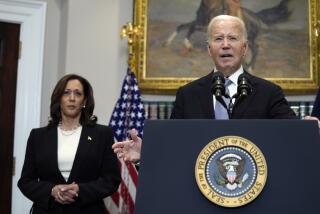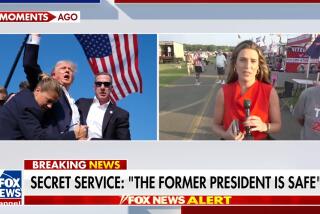Media Politics : TV Political Coverage--Timing, Image, Doughnuts
- Share via
TOLEDO, Ohio — The clock.
7:37.13 a.m. CBS producer Janet Leissner is checking out of the Toledo Hilton on four hours’ sleep. Six dollars for a doughnut and coffee. Wake up correspondent Bob Schieffer. Load two camera crews into their spots in George Bush’s campaign motorcade, and off into the Ohio drizzle.
So it begins, again.
There are moments, in the spaces between the exhaustion and the adrenaline, when one can feel the phantom that haunts this presidential race.
The ghost is the memory of Ronald Reagan’s successful presidential races. The prevailing theory now is that the presidency is won by controlling the images and sound bites that appear on television news.
Control of the image--rather than answering journalists’ questions or satisfying experts on the positions--is the key, this year’s thinking goes. Politicians want to duplicate that. Journalists want to stymie it.
And much of this struggle for the image is played out in the decisions and concerns each day of Leissner and correspondent Schieffer, the main CBS team covering Bush, and the roughly 20 other network producers and correspondents with the two candidates.
How do these journalists choose what to put on the air? Are they really so easily manipulated? Why can’t the media make these candidates stand up and fly right? The answers are elusive, but a close look at what goes into getting a single campaign story on the air--in this case last Friday--does offer some insight into what forms the political reality of 1988 that most Americans see.
8:30.27 a.m. Leissner and Schieffer, CBS’ chief Washington correspondent and anchor of the Saturday Evening News, have worked together for 1 1/2 years.
Schieffer, one of the network’s most valued and respected correspondents, is a self-deprecating Texan with an impish smile who chuckles at being mistaken for Dan Rather or John Chancellor but who maintains an infectious curiosity even in this, his sixth presidential campaign.
Leissner, a fashionable woman who gets teased about her umbrella matching her purple and blue outfit, is more serious in demeanor. She seems to thrive on the constant oppression of logistics. Her world is a kind of perpetual wave of small details easily but dangerously forgotten.
8:46.07 a.m. Because of the clock, there are two realities in the world of campaign television politics--network and local.
Network reality is the early part of the day, everything before roughly 2 p.m. Eastern time. Anything after that is unlikely to make nightly network news, because Leissner, Schieffer and their counterparts will have broken away to local affiliates’ newsrooms or to satellite trucks to produce their stories.
Cut to Local Reality
Candidates then enter local reality--usually one afternoon rally staged late enough to be carried live on local news.
This day, Bush will give a speech in Toledo from 9:47 a.m. to 10:10 a.m. that will contain whatever substance he might offer that day. Today’s subject: chemical weapons.
Then he will fly to Dayton and travel to nearby Troy for a rally from 12:57 to 1:15 p.m., an event largely designed to provide pictures to reinforce visually Bush’s message. Leissner predicts that his remarks will be “boilerplate” attacks on Massachusetts Gov. Michael S. Dukakis--and the prediction proves accurate.
In the late afternoon, Bush will fly to Columbus for a 5:30 rally designed for local news. Leissner has arranged a CBS satellite truck to be there, so that if anything happens, the CBS morning news team can send the footage to New York to add to Schieffer’s story.
9:37:17 a.m. Leissner’s two camera crews synchronize the clocks on their video equipment to the digital runners’ watch on Leissner’s left arm, which she glances at every few seconds throughout the day. This is crucial.
As Bush begins his speech on chemical weapons, Leissner writes down the exact time to the second at which he begins and ends each paragraph, and the exact times around any sentence she thinks she might use.
This is the strangest irony of television: It is the medium most committed to real time--every second of the day is planned and measured--and yet it is the medium that compresses time the most.
Easy Confusion
It is like the irresistible flickering lie of television itself. The image seems so near to reality--and the easy confusion is what critics find so troubling.
On a typical day, CBS’ crews easily will shoot 10 tapes, recording from two angles nearly every moment George Bush is visible in public. Yet the longest story Leissner and Schieffer are likely to get on air is two minutes. A minute and a half is more common.
Since the Republican convention, for instance, Schieffer has a total of 38 minutes on the air. But CBS’ camera crews have more than 200 tapes, 70 hours.
9:49.53 a.m. As Bush speaks, two separate CBS camera crews record the event, one shooting the speech straight from a platform in the back of the room, the other wandering the room or standing on a side platform shooting “cutaway” shots of the crowd.
Why is it Bush and Dukakis are so often photographed from below, in that heroic style made famous by John F. Kennedy? The reason is that the cutaway crews are usually given room on the floor in front of the podium to kneel and shoot close-ups.
10:17.41 a.m. Leissner and Schieffer are calling Brian Healy, CBS’ political editor, to explain what they have for the day. Healy will take it into CBS’ 10:30 a.m. story meeting, at which the first lineup of stories for the nightly news is examined.
“It’s not all that new and different,” Schieffer will say of Bush’s speech later.
Leissner, meanwhile, is worried about getting the necessary equipment to produce a story from Portland, Me., on Monday, three days ahead.
Should she have the phone company install a special line that will carry both audio and visual data to New York and send that way? Should she and Schieffer fly to Boston to produce the story? Is there a CBS affiliate in Maine? If so, she needs to then arrange to have editing equipment and an editor sent to Maine for the cutting session Monday afternoon. If not, she will need to arrange for a satellite truck and support staff to be there. Then, how does she get Schieffer and herself from Maine to Columbus that night to catch up with Bush?
10:42.43 a.m. Back on the phone with political editor Healy. There is no decision yet on whether they will use a story.
12:45.17 p.m. It is raining in Troy and the Bush campaign has moved the rally indoors to Hobart Arena, an ancient hockey rink that looks like something from the movie “Hoosiers.” The picture says Middle America, church, malted milks and tall corn: the candidate flanked by three high school bands and 10 pompon girls in saddle shoes.
As Bush finishes his speech attacking Dukakis, advance man Bruce Zanca takes the cutaway crews to an area specially arranged behind the podium. On cue, Bush knows to turn around to the cameras so that he can be shot with balloons falling into the crowd behind him, a splendid shot.
“This is a fabulous picture,” Schieffer will say later in the editing room.
“Look at these,” Leissner will say. “All these shots.”
Contact With Bureau
1:15 p.m. Emil Boisko has driven in from the CBS bureau in Chicago with editing equipment and taken it to the CBS affiliate WHIO in Dayton. After the speech in Troy, he picks up Schieffer and Leissner, too, and drives them to the station. Leissner arranged the details at least a day ahead.
1:23.53 p.m.
On the drive to WHIO, Schieffer and Leissner plot their story.
“The Administration has already proposed this,” Schieffer says of Bush’s chemical weapons proposal, and it was similar in many ways to what Bush had said earlier in the week.
So Schieffer is thinking of a political story about Bush’s chances here. “The fact of the matter is he drew two huge crowds in what’s supposed to be a key battleground state . . . where Democratic party registration is 2 to 1.”
They agree to offer a short piece--a minute and 15 seconds.
They will need a strong visual to open with, perhaps footage from the airport, then do the chemical speech very quickly and move on to the rally. Since Schieffer did not tape a stand-up on camera to finish the piece, they need strong pictures for the ending.
1:52.28 p.m. At the station, editor Bonnie Bloom has flown in from the Chicago bureau and is waiting to edit their piece. Schieffer and Leissner are on the phone with Healy in New York.
It now appears there may not be a separate Bush story. The decision isn’t entirely because Bush did not make news. Rather, they have a story about campaign financing that already has been scheduled and held for three days. And they wrapped Dukakis into Schieffer’s Bush story the day before. Today, for balance, they will wrap Bush into correspondent Bruce Morton’s Dukakis story.
Exact Time Noted
They pick their sound bites and pictures to send to Morton & Co., settling on three particularly rough attacks against Dukakis from the afternoon, which Leissner identifies for editor Bloom from her notes by the exact time at which they occurred in the day. The tapes speed by in the editing machine in step, the exact time at which they occurred.
Why these harsh sound bites?
“They are the new ones,” Leissner says. “Everything else I’ve heard before.”
Thus, given the choice of rather abstract arguments on the danger of chemical weapons shot against a blue curtain, or some dramatic attacks on Dukakis inside the hockey rink, they leaned toward the attack. Healy in New York also wants a sound bite about chemical weapons.
6:37.18 p.m. At ABC, correspondent Brit Hume does a full story on Bush this day, noting the “good cop-bad cop” rhythm of the day, giving the chemical weapons speech and the rally equal time. Hume notes that Bush has cast three tie-breaking votes in the Senate to allow the Administration to produce chemical weapons. From the arena in Troy, Hume selects a Bush attack line against Dukakis that the vice president flubbed badly.
NBC skipped Bush this day, using only some footage of him at the Dayton airport. Instead, NBC did a feature on how Reagan was campaigning hard for Bush. If Bush had made real news Friday, he might have earned two campaign stories on NBC.
Used at Back End of Story
CBS in New York uses the one sound bite on chemical weapons at the back end of the Dukakis story.
Leissner and Schieffer worry about being used, certainly, but they also, like many journalists here, think that many critics and many politicians overestimate the media’s impact. Bush, Schieffer argued, is not ahead in the polls because of better backdrops.
But such philosophizing is not what dominated the brief discussion about the story Friday in the back of Emil Boisko’s van on the way from Hobart Arena.
It was time. How much time for the piece? Which shots were dramatic enough to fit the opening, which to fit the close? And how long to drive to WHIO in Dayton?
“When this year is over,” Leissner says, looking down at the digital watch on her arm. “I’m throwing this thing away.”
More to Read
Get the L.A. Times Politics newsletter
Deeply reported insights into legislation, politics and policy from Sacramento, Washington and beyond. In your inbox twice per week.
You may occasionally receive promotional content from the Los Angeles Times.








